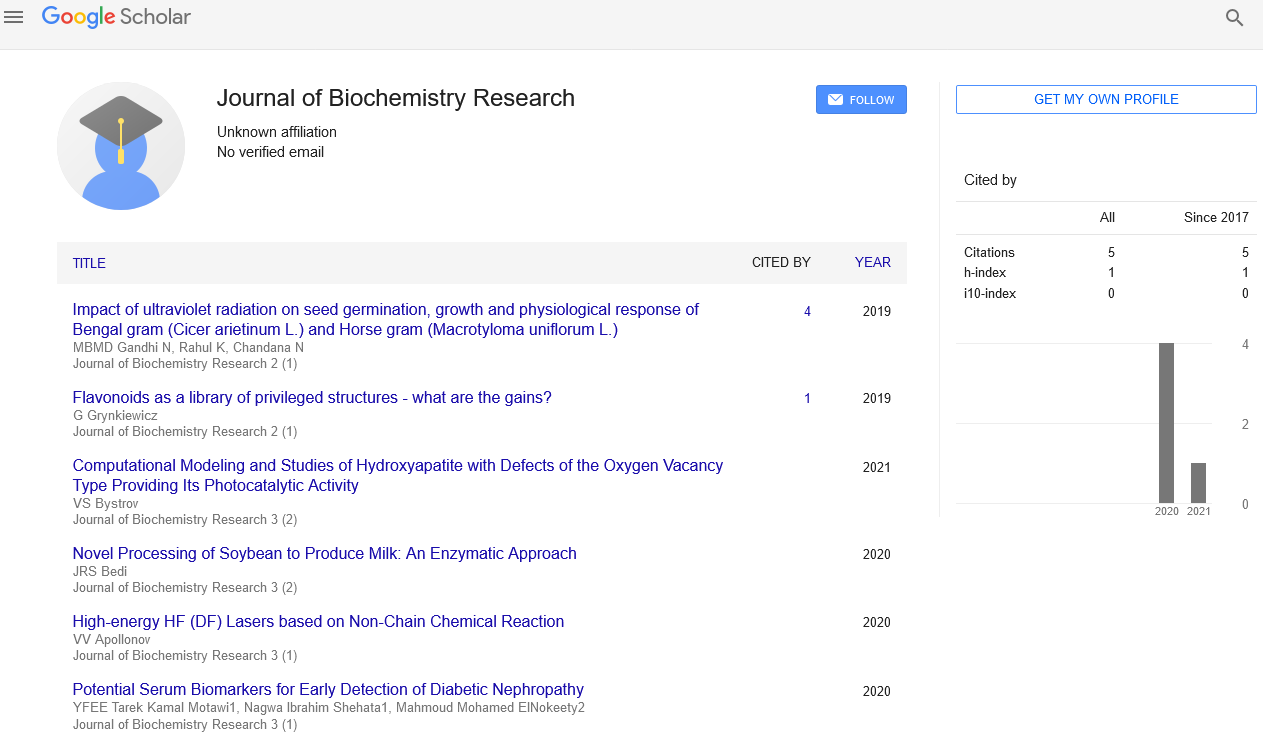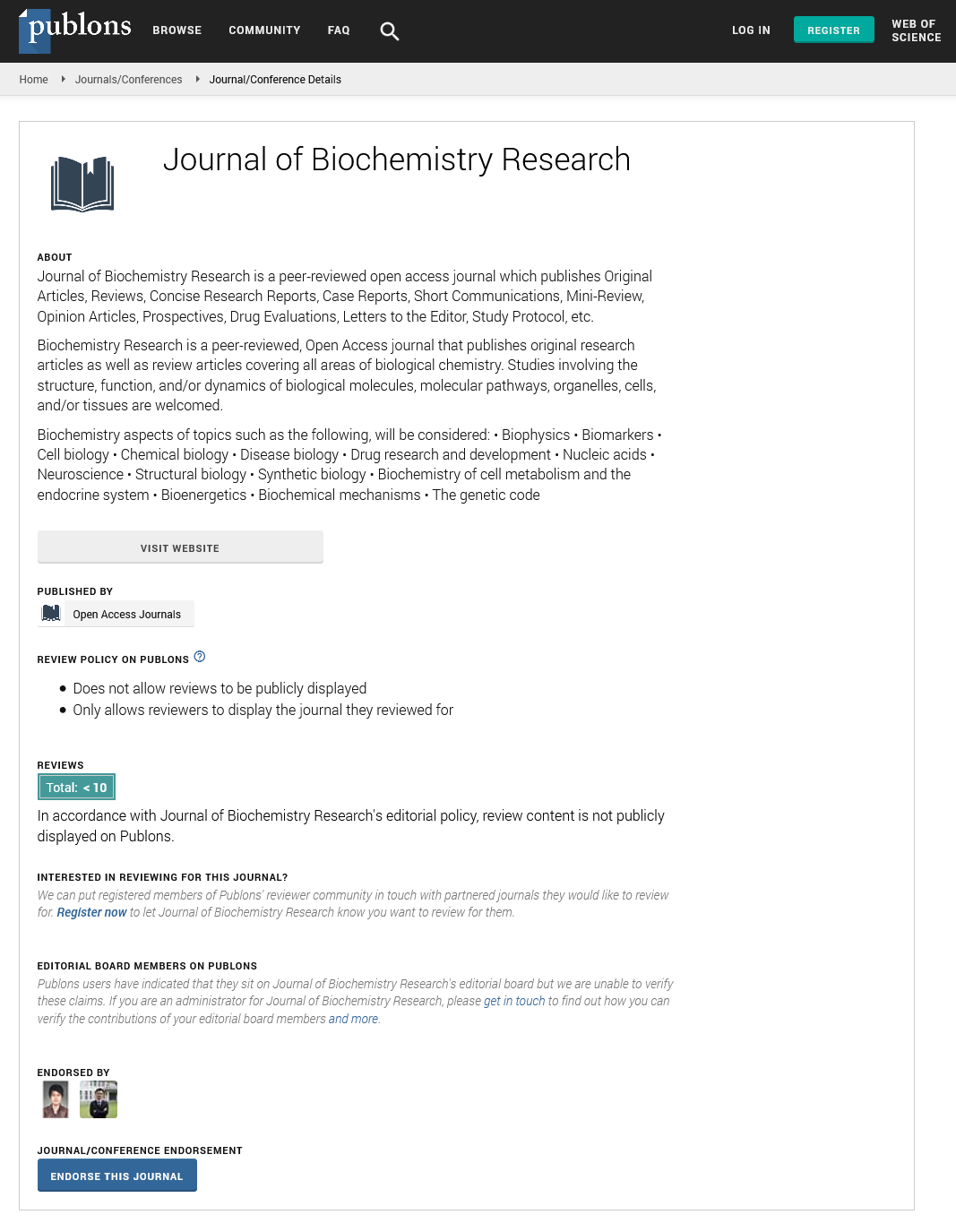Editorial - Journal of Biochemistry Research (2023) Volume 6, Issue 4
Deciphering Molecular Pathways: Unraveling the Intricacies of Cellular Signaling and Regulation
Tejasvi Prakash*
Department of Molecular Biology, University Of Nepal, India
Department of Molecular Biology, University Of Nepal, India
E-mail: TejasviPrakash43@gmail.com
Received: 1-August-2023, Manuscript No.oabr-23-109722; Editor assigned: 4- August-2023, Pre-QC No.oabr-23-109722 (PQ); Reviewed: 14-August-2023, QC No.oabr-23-109722; Revised: 22-August-2023, Manuscript No.oabr-23-109722 (R); Published: 31-August-2023 DOI: 10.37532/ oabr.2023.6(4).111-113
Abstract
The study of molecular pathways represents a captivating and indispensable journey into the intricate web of cellular signaling and regulation. These pathways are essential for orchestrating the diverse array of cellular processes that sustain life and maintain cellular homeostasis. This article delves into the multifaceted world of molecular pathways, exploring their complexities and revealing the underlying mechanisms that govern cellular communication and response. Drawing from the fields of molecular biology, biochemistry, and systems biology, this investigation delves into the molecular components and interactions that comprise these pathways. Specific emphasis is placed on signaling cascades involving proteins, lipids, nucleic acids, and small molecules, which intricately transmit information and coordinate cellular activities. Understanding the regulation of molecular pathways is equally paramount, as it governs the timing and magnitude of cellular responses to various stimuli. This regulation involves an array of molecular switches, feedback loops, and dynamic interactions that fine-tune cellular processes in response to changing environmental cues. Moreover, the exploration of molecular pathways extends beyond intracellular communications, encompassing intercellular and extracellular signaling networks. Cell-to-cell communication and signaling within tissues and organs shape complex physiological responses and contribute to the robustness of multicellular organisms. This article also delves into the implications of deciphering molecular pathways in the context of human health and disease. Dysregulation of these pathways underlies various pathological conditions, and understanding the molecular basis of diseases offers novel therapeutic avenues and precision medicine strategies. In conclusion, the exploration of molecular pathways provides a profound understanding of the intricacies of cellular signaling and regulation. Unraveling the molecular components, interactions, and dynamic feedback mechanisms that underpin these pathways opens up new frontiers for advancing biotechnology, drug discovery, and personalized medicine. As we continue to decipher the molecular language of cellular communication, we gain valuable insights into the fundamental mechanisms that govern life’s processes and empower ourselve
Keywords
Molecular pathways • Cellular signaling • Regulation • Cellular communication
Introduction
The intricate dance of life within a cell is orchestrated by a complex network of molecular pathways that govern cellular signaling and regulation [1]. Deciphering these molecular pathways lies at the heart of modern life sciences, as they are fundamental to understanding the coordination and integration of cellular processes [2]. From responding to external stimuli to maintaining internal homeostasis, these pathways play a pivotal role in ensuring the proper functioning of cells and ultimately shaping the physiology of multicellular organisms. In this exploration, we embark on a captivating journey into the world of molecular pathways, seeking to unravel the intricacies of cellular signaling and regulation [3]. These pathways encompass a diverse array of molecular components, including proteins, lipids, nucleic acids, and small molecules, each contributing unique insights into the sophisticated language of cellular communication. At the core of our investigation lies the understanding of cellular signaling, where information is relayed from the cell’s exterior to its interior. Signaling cascades, composed of molecular interactions and dynamic feedback loops, transmit these messages, guiding the cell’s response to diverse environmental cues [4]. The timing and magnitude of these responses are precisely regulated, ensuring that cellular activities are finely tuned and appropriate to the cell’s needs. Beyond intracellular communication, molecular pathways extend their reach to intercellular and extracellular signaling networks. Intercellular communication fosters collaboration among cells within tissues and organs, orchestrating complex physiological responses that sustain life in multicellular organisms. Unraveling the complexity of these pathways enables us to appreciate the robustness and adaptability of cellular processes in the context of diverse biological systems [5]. Moreover, the implications of deciphering molecular pathways are far-reaching, transcending the realms of basic science. The dysregulation of these pathways underlies various pathological conditions, making them critical targets for understanding the molecular basis of diseases [6]. This knowledge paves the way for novel therapeutic avenues and precision medicine strategies, where interventions are tailored to individual molecular profiles, ultimately leading to more effective treatments and improved patient outcomes. As we delve deeper into the intricacies of cellular signaling and regulation, we unlock the secrets of life’s most fundamental processes [7]. The quest to decipher molecular pathways is one that continues to drive transformative advancements in biotechnology, drug discovery, and personalized medicine. By understanding the language of cellular communication, we empower ourselves to navigate the complexities of health and disease with unprecedented precision, thus propelling us toward a future where the mysteries of life are unravelled, and human well-being is enriched [8].
Discussion
Molecular Components of Pathways: Participants can delve into the specific molecular components that make up cellular signaling pathways, such as receptors, kinases, transcription factors, and second messengers [9]. Understanding the roles and interactions of these molecules provides insights into how information is transmitted within the cell. Signaling Cascades and Feedback Loops: The discussion can focus on specific examples of signaling cascades and feedback loops, where molecular signals trigger a series of sequential events, culminating in cellular responses [10]. Participants can explore how feedback mechanisms fine-tune these responses, maintaining cellular homeostasis. Dynamic Nature of Pathways: Cellular signaling pathways are dynamic and responsive, adapting to changing conditions and stimuli. The discussion can explore how pathways respond to environmental cues and how their regulation ensures appropriate cellular responses. Crosstalk and Integration of Pathways: The crosstalk and integration of different signaling pathways are crucial for coordinating cellular processes. Participants can discuss how multiple pathways converge to regulate complex cellular behaviors and how dysregulation can lead to disease. Intercellular and Extracellular Signaling: The discussion can extend to intercellular and extracellular signaling networks, where cells communicate with one another and respond to signals from their microenvironment. The impact of these signaling networks on tissue physiology and organismal development can be explored. Systems Biology Approaches: Participants can discuss the application of systems biology approaches, such as computational modeling and network analysis, to deciphering molecular pathways. These approaches help uncover emergent properties and reveal the global behavior of signaling networks. Molecular Basis of Diseases: Understanding the dysregulation of signaling pathways is crucial for unraveling the molecular basis of diseases. Participants can explore how defects in signaling components contribute to various disorders, and how this knowledge informs the development of targeted therapies. Therapeutic Opportunities: The discussion can address the therapeutic opportunities arising from deciphering molecular pathways. Participants can explore how targeting specific components of pathways can lead to more effective treatments and personalized medicine approaches. Challenges in Studying Pathways: The exploration of molecular pathways is not without challenges. Participants can discuss the complexities of experimental techniques, the difficulty of studying pathway crosstalk, and the limitations in translating findings from model organisms to human biology. Ethical Considerations: Ethical considerations in the context of cellular signaling and regulation can also be discussed, such as the use of animal models for pathway studies and the implications of targeted therapies on patient well-being.
Conclusion
In conclusion, the exploration of deciphering molecular pathways and unraveling the intricacies of cellular signaling and regulation has taken us on a captivating journey through the fundamental mechanisms that govern life at the cellular level. From the interplay of molecular components to the dynamic feedback loops and complex integration of pathways, we have gained profound insights into the sophisticated language of cellular communication. The study of molecular pathways has illuminated the remarkable adaptability and responsiveness of cells, enabling them to sense and respond to diverse environmental cues with precision and efficiency. Signaling cascades, feedback loops, and crosstalk among pathways work in harmony to orchestrate cellular processes, ensuring proper functioning and maintaining homeostasis in the face of changing conditions. Beyond intracellular communication, we have explored the significance of intercellular and extracellular signaling networks, which contribute to the robustness of multicellular organisms. The intricate coordination between cells within tissues and organs shapes complex physiological responses, underscoring the interconnectedness of life’s processes at the organismal level. The implications of deciphering molecular pathways extend far beyond the confines of scientific inquiry. Understanding the dysregulation of these pathways has illuminated the molecular basis of various diseases, offering new vistas for targeted therapies and precision medicine. As we gain insights into the molecular signatures of diseases, we pave the way for personalized interventions that can improve patient outcomes and enhance the quality of life. The journey of deciphering molecular pathways has not been without challenges, as the complexities of cellular signaling demand innovative experimental techniques and systems biology approaches. Ethical considerations remind us of the responsibility to use knowledge responsibly, balancing scientific exploration with the welfare of research subjects and society. As we conclude this exploration, we are reminded of the profound interconnectedness between molecular pathways and the intricate web of life they govern. This understanding empowers us to navigate the complexities of health and disease with unprecedented precision, propelling scientific advancements and transforming healthcare practices. As we continue to unravel the mysteries of cellular signaling and regulation, we embrace the limitless possibilities that lie ahead. The quest for knowledge is never-ending, and with each discovery, we come closer to unlocking the secrets of life’s most fundamental processes. It is through this relentless pursuit that we foster a deeper appreciation for the beauty and complexity of the living world, and with it, the potential to usher in a new era of biomedicine and improved human well-being.
References
- Nickel T, Hanssen H, Sisic Z et al. Immunoregulatory effects of the flavonol quercetin in vitro and in vivo. European Journal of Nutrition. 50, 163-172 (2011).
- Moro T, Shimoyama Y, Kushida M et al. Glycyrrhizin and its metabolite inhibit Smad3-mediated type I collagen gene transcription and suppress experimental murine liver fibrosis. Life Sciences. 83, 531-539 (2008).
- Kolasa KM, Rickett K. Barriers to providing nutrition counselling cited by physicians. Nutrition in Clinical Practice. 25, 502-509 (2010).
- Glanz K. Review of nutritional attitudes and counselling practices of primary care physicians. American Journal of Clinical Nutrition. 65, 2016-2019 (1997).
- Holeček M. Nutritional modulation of liver regeneration by carbohydrates, lipids, and amino acids. Nutrition. 15, 784-788 (1999).
- Nishiura T, Watanabe H, Ito M et al. Ultrasound evaluation of the fibrosis stage in chronic liver disease by the simultaneous use of low and high frequency probes. British Journal of Radiology. 78, 189-197 (2005).
- Ma CX, Luo J, Ellis MJ et al. Molecular profiling of triple negative breast cancer. Breast Disease. 32, 73-84 (2010).
- Ellis MJ, Ding L, Shen D et al. Whole-genome analysis informs breast cancer response to aromatase inhibition. Nature. 486, 353-360 (2012).
- Perou CM. The genomic landscape of breast cancer as a therapeutic roadmap. Cancer Discovery. 3, 27-34 (2013).
- Wang H, Mao X. Evaluation of the efficacy of neoadjuvant chemotherapy for breast cancer. Drug Design Development and Therapy. 14, 2423-2433 (2020).
Google Scholar, Crossref, Indexed at
Google Scholar, Crossref, Indexed at
Google Scholar, Crossref, Indexed at
Google Scholar, Crossref, Indexed at
Google Scholar, Crossref, Indexed at
Google Scholar, Crossref, Indexed at
Google Scholar Crossref, Indexed at
Google Scholar, Crossref, Indexed at
Google Scholar, CrossrefIndexed at


